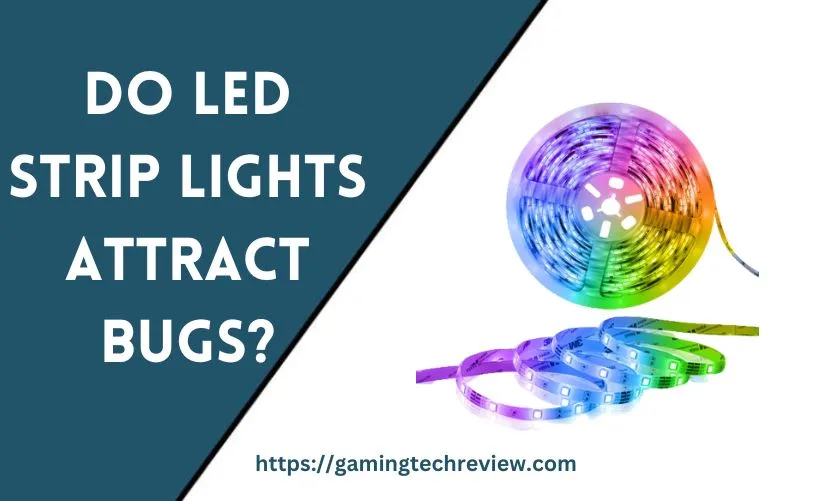
In the world of lighting, LED strip lights have become increasingly popular for their versatility, energy efficiency, and aesthetic appeal. Whether you’re using them for accent lighting indoors or to illuminate your outdoor spaces, these sleek and vibrant lights have found their way into countless homes and commercial settings. However, a common question that often arises is whether LED strip lights attract bugs.
The notion that lights, in general, attract insects is not new, but the specific behavior of bugs around LED strip lights has sparked curiosity and concern. In this comprehensive 3000-word blog post, we will delve into the science of insect attraction to light, investigate the factors that may make LED strip lights more or less appealing to bugs, provide practical advice for minimizing bug interference, and discuss the numerous advantages of using LED strip lights in various settings despite the bug-related concerns.
Understanding Bug Attraction
Factors That Attract Bugs
Before we dive into the world of LED strip lights and their impact on bugs, it’s essential to understand the factors that influence insect attraction to light.
- Light Wavelength and Spectrum: Insects are highly sensitive to specific wavelengths of light, especially ultraviolet (UV) and blue light. These wavelengths are commonly associated with bug attraction.
- Light Intensity: Bright lights tend to attract more bugs than dim ones. The intensity of the light source plays a crucial role in determining the extent of bug interference.
- Color Temperature: The color temperature of light sources, measured in Kelvin (K), also affects bug attraction. Lights with cooler color temperatures (higher Kelvin values) tend to attract more bugs than warmer ones.
- Motion and Heat: Some insects are attracted to light sources due to the heat they emit or because they mistake stationary lights for sources of heat.
The Science Behind Bug Attraction to Light
The phenomenon of bugs being drawn to light has fascinated scientists for years. Research suggests that bugs use natural sources of light, such as the moon and stars, for navigation. Artificial lights can disrupt their navigation patterns, causing them to circle the light source. However, the exact reasons behind bug attraction to artificial light sources like LED strip lights remain a subject of ongoing study.
See Also: Why Wi-Fi Works on Your Phone, But Not Your Laptop: Troubleshooting Tips
LED Strip Lights: The Basics
Before we explore bug attraction in detail, let’s establish a foundation by understanding LED strip lights.
Explanation of LED Technology
LED stands for Light Emitting Diode. These lights work by passing an electric current through a semiconductor, which then emits light. Unlike traditional incandescent bulbs, LEDs don’t rely on heating a filament to produce light, making them incredibly energy-efficient.
Advantages of LED Strip Lights
- Energy Efficiency: LED strip lights consume significantly less energy compared to traditional light sources, making them an eco-friendly option.
- Longevity: LEDs have a longer lifespan, reducing the frequency of replacements.
- Color Variety: LED strip lights come in various colors, allowing for creative lighting solutions.
- Flexibility: They are thin, lightweight, and flexible, making them suitable for various applications.
Bug Attraction and Traditional Light Sources
Now that we have a basic understanding of LED strip lights and bug attraction, let’s compare how traditional light sources affect insects.
How Traditional Light Sources Attract Bugs
- Incandescent Bulbs: Incandescent bulbs emit warm, yellow light, which is less likely to attract bugs compared to cooler, bluish light.
- Fluorescent Bulbs: Fluorescent lights tend to emit UV light, which can attract insects.
- Halogen Bulbs: Halogen bulbs produce a considerable amount of heat, which can attract insects seeking warmth.
Comparing Bug Attraction of Traditional Lights to LEDs
In comparison to traditional light sources, LED strip lights present several factors that can influence bug attraction differently.
LED Strip Lights and Bug Attraction
Myths and Misconceptions About LED Strips
One common misconception is that LED strip lights attract bugs more than other types of lights. However, the reality is more nuanced.
Factors Affecting Bug Attraction in LED Strip Lights
- Light Wavelength and Spectrum in LEDs: LED strip lights can be designed to emit specific wavelengths, including those less appealing to bugs.
- Light Intensity in LED Strips: The brightness of LED strip lights can vary widely, allowing users to choose options with lower intensity to minimize bug attraction.
- Color Temperature of LED Strips: LED strips come in a range of color temperatures, providing flexibility in selecting a temperature that is less attractive to bugs.
- Motion and Heat Generated by LED Strips: LED strips typically produce less heat than traditional incandescent or halogen bulbs, which may reduce bug attraction related to heat.
Studies and Research on LED Strip Lights and Bugs
To shed light on this topic, let’s examine some scientific findings and real-world experiences regarding LED strip lights and bug attraction.
Tips for Minimizing Bug Attraction with LED Strip Lights
While it’s challenging to eliminate bug attraction entirely, there are practical steps you can take to minimize interference.
- Proper Installation Techniques: Position LED strip lights strategically to direct light away from areas where bug interference is undesirable.
- Choosing the Right LED Strip: Select LED strips with warmer color temperatures and lower light intensity when bugs are a concern.
- Using Bug-Resistant Coatings and Accessories: Some products are designed to reduce bug interference, such as bug-resistant LED covers and coatings.
- Timers and Dimmers for Bug Reduction: Install timers or dimmers to control when and how long your LED strip lights are active, reducing bug attraction during peak insect activity times.
- Maintaining a Clean Outdoor Environment: Regularly clean outdoor spaces to remove debris and insects that may be attracted to the lights.
Practical Applications of LED Strip Lights
Despite bug-related concerns, LED strip lights offer numerous advantages and creative lighting possibilities.
Outdoor Lighting Ideas with LED Strips
- Accent Lighting: Illuminate gardens, walkways, and outdoor seating areas with LED strip lights to create a warm and inviting atmosphere.
- Security Lighting: Use LED strips for motion-activated security lighting, enhancing safety around your property.
- Holiday and Event Lighting: Decorate for holidays and special occasions with colorful LED strip lights.
Indoor Lighting and Decor with LED Strips
- Under-Cabinet Lighting: Install LED strips under kitchen cabinets for functional and stylish task lighting.
- Ambient Lighting: Create mood lighting in living rooms, bedrooms, and home theaters with LED strip lights.
- Art and Display Lighting: Highlight artwork and collectibles with discrete LED strip lighting.
See Also: Troubleshooting and Care for Your HP Laptop Keyboard
Environmental Benefits of LED Strip Lights
It’s worth noting that despite the bug-related concerns, LED strip lights offer significant environmental advantages.
Energy Efficiency and Reduced Environmental Impact
LED strip lights are highly energy-efficient, consuming far less electricity than traditional incandescent or fluorescent bulbs. This efficiency translates into reduced energy bills and a lower carbon footprint.
Longevity and Reduced Waste
LEDs have a longer lifespan than traditional bulbs, which means fewer replacements and less waste. This contributes to a more sustainable and eco-friendly lighting solution.
Conclusion
In conclusion, the question, “Do LED strip lights attract bugs?” has a multifaceted answer. While LED strip lights can indeed attract some insects, their bug-attracting potential is generally lower compared to traditional light sources, provided you choose the right type of LED strips and follow practical bug-reduction strategies.
The advantages of LED strip lights, such as energy efficiency, longevity, color variety, and flexibility, outweigh the bug-related concerns for most users. By understanding bug attraction factors and taking proactive steps, you can enjoy the benefits of LED strip lights in various settings without being overrun by insects.
So, when considering LED strip lights for your lighting needs, don’t let the fear of bugs deter you from embracing this versatile and environmentally friendly lighting solution.










